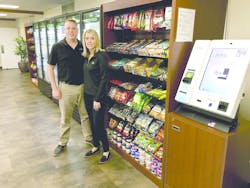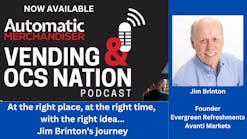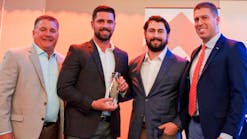Ryan Harrington, Co-CEO of Royal Vending, came into the vending industry during a challenging time. The economy was in recession and the reputation of vending in the Portland, OR, area was poor. Companies asking for vending complained about a lack of response from their service providers, and most didn’t even know their route drivers. Harrington used this to his advantage by starting small with dedicated service and working to maintain his attention to customers even as he grew Royal Vending, based in Tigard, OR, into a full-line vending, micro market and office coffee service operation. He embraced technology, such as going 100 percent cashless on vending machines and using an online vending management system. However, it is micro markets that have truly captivated his region and drove profits since the company placed its first in 2014. Micro market revenues, which include hybrid micro market pantry service, overtook vending the next year and now account for the majority of the $2.4 million in annual revenue.
Unattended profits
The path to becoming a vending operator started for Harrington on a Ferry in 2006. “I was waiting in a 12-person line to get a soda from the vending machine when I thought, ‘the owner of this machine isn’t even here and is making money,’” recalled Harrington. He was working as a real estate investor and looking for a business he could do during downtime in-between transactions. Vending seemed to be perfect. He did research and by the next year had purchased two new, branded Red Bull machines and found locations to place them. “I just kept doing that, a couple of machines at a time,” said Harrington. “I rented a truck and serviced them myself.”
Around 2009, when the real estate market was in decline, Harrington was thinking about entering another line of work. His wife, Michelle, suggested going into vending full time. He had already placed 40 vending machines, and was doing so well selling Red Bull, the company was giving him free machines.
“I wondered if I could go into business in the Portland environment and treat everyone with the same high standard of service,” he said. He decided to give it a try and opened Royal Vending with his wife. Within two years they had built up enough routes that they needed a commercial warehouse space and brought on some employees, including Michelle who left her career in human resources (HR) to manage Royal Vending full time.
Manual forecasting
One of the things that set Harrington’s vending machine operation apart was that he started with dynamic routing from the start. “I would track every sale and use formulas in Microsoft Excel to forecast future sales and make routes,” he said. He had no idea there was such a thing as a static route until he started talking to other operators at trade shows.
At the 2014 NAMA trade show, he and Michelle saw the micro market concept. By January 2015, they had installed the first one and had more planned. Michelle immediately recognized micro markets as a HR benefit. She helped create programs specially targeted to helping HR professionals meet employee needs and increase benefits with micro markets, and eventually pantry service offerings. The focus worked, partly because Portland has a number of technology companies. “Many companies want to offer refreshment on-site, whether that is free product, cheaper subsidized options or just better product variety,” explained Harrington. He rarely deals with a purchasing manager or facility manager anymore, but communicates with the wellness committee or personnel department. “That shows the change in thought process for locations,” he said.
Launching micro markets also showed the Harringtons how much they could be benefiting from more streamlined sales and forecasting analysis, so they opted to add an online vending management system (VMS) in 2015, as well as accompanying cashless readers. “It was really easy to upgrade because we were already prekitting, already dynamic scheduling and already had micro markets,” said Harrington. “The VMS just made it all more efficient and less labor intensive.” He used that extra time to grow micro markets.
The revenue from micro markets over took vending revenues in 2015 and continued to increase. Vending now only makes up around 35 percent of annual sales with the rest being micro markets, pantry service and office coffee service (OCS). “In a matter of two years, vending machines became only a third of our business,” said Harrington, “after all those years of working to add vending accounts.” Despite this, Harrington is grateful for the change. “Micro markets increase sales, service calls go to zero and the account is happier.”
Building on the success of micro markets, Royal Vending began adapting the way it sold refreshment services. “When someone calls for vending, we pitch a micro market or pantry service. Vending machines are the last resort,” he said.
Royal Vending has a well crafted and streamlined marketing strategy for micro markets as well as the installation. The presentation uses slides and sample photos of layouts. The key, however, is making the switch to micro markets easy and worry free. “Every week we do one,” said Harrington. “Install on Monday. Grand opening, Wednesday. No contracts or money from the location. We take care of everything.” Royal Vending will even work with the previous vending company for removal of equipment.
The lack of contract is a point of difference for Royal Vending. “We are so confident that they will appreciate the service and like it, that we don’t require a contract,” Harrington said. He will often offer to remove the micro market upfront, if it doesn’t work, which sets the location’s mind at ease. He says that 99.9 percent of the time, the location loves it, however.
Local retail displays
Royal Vending has made micro market installation an art, down to how quickly its customized fixtures and cabinets and kiosk take to install. “We can have one up in a couple of hours and remove one in an hour,” explained Harrington. He and Michelle went to a local store fixture company and cabinet maker to get their micro market displays. It allowed them to make the fixtures the same height as the coolers as well as pick the style and finish they wanted. It also allows them to reinforce the Royal Company Market name, the brand Royal Vending uses for its micro markets.
The creation of fixtures locally also keeps costs low, Harrington finds. He has considered ordering fixtures from elsewhere, but shipping costs are a challenge. He finds his current suppliers are more convenient and half the price than other offerings.
While locations like to be part of the design process of the micro market, Harrington finds he gets called in after the break room remodel is done. The location usually asks him to compliment the new decor or style, rather than help redesign an old break room.
Royal Vending has a variety of micro market sizes as well. “We’ll install a traditional micro market for 90 people or more, if they are all onsite, especially if its a 24-hour location,” he said. For smaller locations, Royal Vending uses a micro market hybrid. There is a monthly subsidy paid for by the location, perhaps for healthy items, which ends up going into the employee accounts. “We will put $20 a month into the employee accounts,” said Harrington. “No one pays us to put in a micro market. Instead it all goes towards employees so they buy more, so we can have more fresh food.”
Focused on fresh food
While fresh food can be difficult to manage due to short shelf life and high spoilage, Harrington feels it is vital. “It is the centerpiece of a micro market,” he said. “It is what brings them in.” In an effort to reduce the amount that has to be thrown away, Royal Vending keeps a low margin on fresh food which induces sales. The revenues support this strategy as Harrington reports that he rarely sees a purchase of just a fresh food item. Usually, the food item is accompanied by a snack and or beverage. “Our whole goal with subsidies is to put more fresh food into the micro market,” Harrington said. It might drive up waste, but it also drives up sales.
Part of Harrington’s plan for the future is capturing all the locations that shy away from vending machines, but don’t qualify for micro markets, with the hybrid option and also high service. “Our region is micro market saturated,” he admitted. “The benefit is that locations are educated about micro markets and their benefits.” This makes the location more receptive to a subsidy program when Harrington explains he can give them a micro market-like experience. As the last independent company in the area, he also focuses on keeping top tier, personalized service. “We love being independent — we have a lot of years left in us. We want to build this culture and business up. Being local is a great asset,” he said.
Pantry service growing
We think pantry service is the future,” said Harrington. “We think more and more companies will be offering it.” Royal Vending offers a couple versions currently. The first is the kitchen and cabinet restock. This is where a delivery driver will stock the whole kitchen weekly or twice weekly, whatever is needed. “It is more labor intensive,” admitted Harrington, “because the driver inventories and restocks, and then we invoice the location. It can be 5 to 10 times the revenues of a micro market, however.”
The second pantry service option Royal Vending offers is essentially a micro market without the kiosk (and cameras). Harrington has found that this can work very well. For example, a location of 30 employees who are all onsite and working long hours can have the same revenue as a 150 employee micro market. Additionally, the cost of entry is less with no kiosk, but there is more labor and stocking with a higher demand on the manual data. “The lack of product data is a challenge,” commented Harrington. Currently he uses Excel, but hopes to find a company who can streamline the process.
One area essential to support the growing number of Royal Company Markets and Royal Vending pantry service is warehouse management. “When I think back, I started with just beverage vending machines that had maybe 40 SKUs,” said Harrington. “Now with micro markets, there are around 600 SKUs.” Michelle manages that side of the business, working out efficient pick paths and product tracking. She decides what to order and when it should be delivered. Royal Vending does not operate its own commissary, but instead gets fresh food delivered twice a week from three different local kitchens. Harrington gives her a lot of credit for Royal Vending’s prosperity. “Michelle is instrumental in the operations and success of our business,” he said.
Drivers are specially trained
Drivers don’t pick or load product into their vehicles. “We really try to specialize roles,” said Harrington. Drivers stay on the road and merchandise micro markets. Royal Vending has a standard operating procedure for merchandising. Part of that procedure is to clean, answer questions, and maintain the market, including ensuring items look appealing and removing what doesn’t sell. Planograms are all handled in the central office, which keeps all the micro markets looking the same. One advantage of this is cross-training and a consistency of service. “Locations get the same service no matter who is the driver — it’s less variable with less variation,” said Harrington. Any driver can cover for another and the micro market and merchandising responsibilities will all be familiar.
Royal Vending offers drivers hourly pay and bonuses that relate to total sales and expired product. “We have a short dated program for fresh food that doesn’t come into this,” said Harrington. “It’s the other stuff — the chips, bottled drinks, etc. If drivers don’t catch these things, it can cost the company lots of money in product needing to be thrown away.” Drivers are trained on how to find short dated product and pull it in the last two weeks to move to a quick turning location. Doing this well leads to monetary compensation.
There is also an employee recognition program and a focus on culture, because Harrington knows finding the right kind of employee can be challenging “In Portland, the unemployment rate is low, making finding quality employees a bit difficult. Plus we are growing, needing to hire someone new every 3 to 6 months,” said Harrington. “And it’s hard work. All our employees work hard.”
Estores and national partnerships
When looking into the future, the Harringtons value partnerships, both online and offline.
“We are looking at the next step in the industry right now” said Harrington, “an estore.” This would be for the location that doesn’t qualify for full service pantry, but wants to order by the product and have it delivered locally. Royal Vending is working with 365 Retail Markets on a trial of the estore program. Harrington’s main goal is to take care of everything area businesses need. Along with that idea he’s found there are also companies who want to negotiate service for other branches across the nation. This has led Harrington and Michelle to consider the need for some kind of nationwide vending management to compete with large corporations. Therefore, they created an operator network.
“We now have independent operators in various cities as partners,” said Harrington. The operators are all dedicated to service and each coach each other and share ideas, if needed. Many met Harrington at industry trade shows, such as NAMA, or through supplier contacts. The negotiating operation takes a small percentage of the revenue, the remainder going to the operator servicing the local account. Currently, the partnership consists of operations in Atlanta, GA; Denver, CO; Sacramento, CA; Dallas, TX; and New York City, NY. “It’s allowed us to win bids on national accounts looking for service,” reported Harrington. “Really, it’s helped us all.”
Royal Vending isn’t just dedicated to service, it’s dedicated to changing the way things have been. From bringing custom micro markets to locations, hybrid and pantry service concepts to smaller locations and even forming a national network, Royal Vending is pushing the boundaries of traditional workplace service.
All In For Cashless Brings ROI
In 2015, Royal Vending upgraded not only to a vending management system (VMS), but also to 100 percent cashless acceptance. Ryan Harrington knew that cashless readers could use the same signal as the telemetry needed to support the online VMS. He also knew the consumer preference for paying with electronic means was growing, which made going cashless an upgrade to his service. It was a good move. "Sales went up 17 percent across the board once all machines accepted cashless," he said.
Realigning Vending When Your Micro Market Focused
Royal Vending, which started as a vending company, has actually begun reducing the number of vending machines it services. Ryan Harrington, president, shares that the company is eliminating low volume accounts while keeping around 300 vending machines placed in quality locations. "We offer options when we eliminate the account. We ask if they want to subsidize it or we suggest one of our vending partners who will take the location," said Harrington. "It's driving up our vending revenue but not our number of machines."
Operation Profile:
Royal Vending
Headquarters: Tigard, OR
Founder: Ryan Harrington
Number of employees: 11
Micro market provider: 365 Retail Markets
VMS: Parlevel Systems
Cashless payments: USA Technologies
Annual revenue: $2.4 Million

Emily Refermat
Emily began covering the vending industry in 2006 and became editor of Automatic Merchandiser in 2012. Usually, Emily tries the new salted snack in the vending machine, unless she’s on deadline — then it’s a Snickers.
Emily resigned from Automatic Merchandiser and VendingMarketWatch.com in 2019 to pursue other opportunities.







